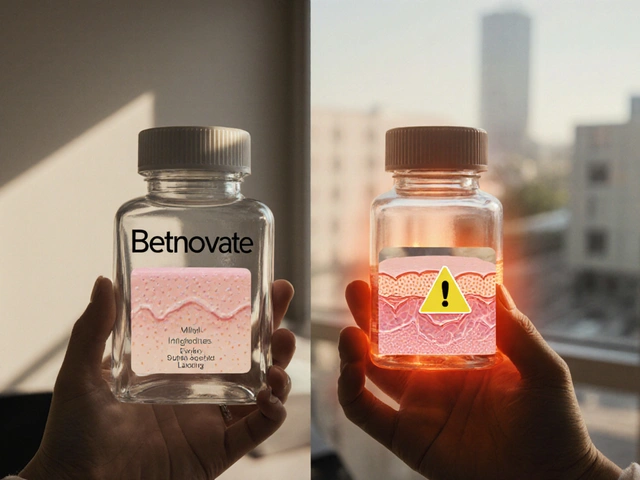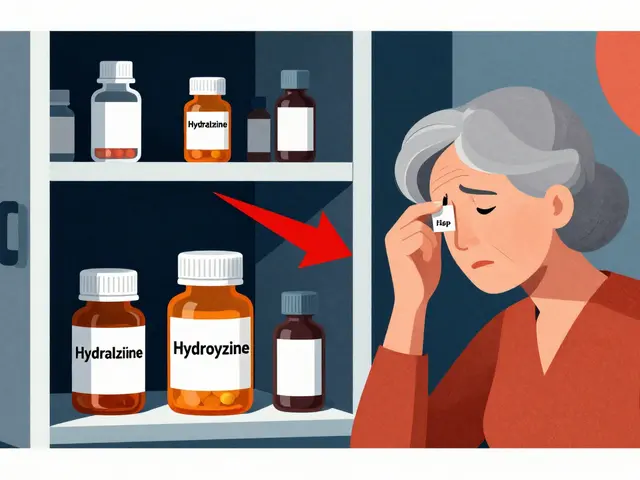
Antibiotic Comparison Tool
Find Your Best Antibiotic Alternative
Select your condition and preferences to see which antibiotic is most appropriate for you.
Recommended Antibiotic
When your doctor prescribes Minocycline - sold under the brand name Minomycin - you probably expect it to clear up acne or tackle a stubborn infection. But what happens if you experience side effects, need a cheaper option, or simply wonder if another drug might work better? This guide breaks down Minocycline alternatives and gives you the facts you need to choose the right antibiotic for your condition.
How Minocycline Works and When It’s Used
Minocycline is a broad‑spectrum tetracycline antibiotic. It blocks bacterial protein synthesis by binding to the 30S ribosomal subunit, halting growth of susceptible microbes. Because of its high tissue penetration, it’s a go‑to for:
- Moderate to severe acne vulgaris
- Rickettsial diseases (e.g., Rocky Mountain spotted fever)
- Lyme disease (early disseminated phase)
- Certain respiratory and urinary tract infections when other drugs fail
Typical adult dosing is 100 mg twice daily, with a half‑life of about 16 hours, allowing once‑daily dosing for some indications. However, the drug carries a reputation for causing photosensitivity, vestibular disturbances, and, rarely, autoimmune reactions.
Why Look for Alternatives?
Patients consider swapping Minocycline for several practical reasons:
- Side‑effect profile: Light‑headedness, dizziness, or severe skin reactions can make adherence tough.
- Cost: In many markets, Minocycline can be pricier than generic tetracyclines.
- Drug interactions: It can reduce the efficacy of oral contraceptives and interact with anticoagulants.
- Resistance patterns: Some regions report rising resistance among Propionibacterium acnes strains.
When any of these flags pop up, it’s time to compare the main alternatives.
Side‑by‑Side Comparison Table
| Antibiotic | Typical Indications | Standard Adult Dose | Common Side Effects | Contraindications | Average Monthly Cost (USD) |
|---|---|---|---|---|---|
| Minocycline | Acne, rickettsial infections, Lyme disease | 100 mg PO BID | Photosensitivity, dizziness, hyperpigmentation | Pregnancy, severe liver disease | $30‑$45 |
| Doxycycline | Acne, STI prophylaxis, tick‑borne diseases | 100 mg PO BID or 200 mg daily | Esophageal irritation, photosensitivity | Pregnancy (first trimester), children <8 y | $15‑$25 |
| Tetracycline | Acne, respiratory infections | 250‑500 mg PO QID | GI upset, photosensitivity | Pregnancy, children <8 y | $10‑$18 |
| Azithromycin | Chlamydia, bronchitis, skin infections | 500 mg PO daily × 3 days | GI upset, QT prolongation | Severe liver disease, known macrolide allergy | $25‑$35 |
| Clindamycin | Severe acne, anaerobic infections | 300 mg PO BID | Diarrhea, C. difficile risk | History of C. difficile colitis | $20‑$30 |
| Trimethoprim‑sulfamethoxazole | UTIs, MRSA skin infections | 800 / 160 mg PO BID | Rash, hyperkalemia | G6PD deficiency, severe renal impairment | $12‑$20 |
| Amoxicillin | Sinusitis, strep throat, dental infections | 500 mg PO TID | Allergic rash, GI upset | Penicillin allergy | $8‑$15 |
Deep Dive into Each Alternative
Doxycycline
Doxycycline is the closest cousin to Minocycline. It shares the same tetracycline class but has a slightly shorter half‑life (about 18 hours) and a simpler dosing schedule. In acne studies, doxycycline’s efficacy is comparable, though some patients report fewer vestibular side effects. It’s also the first‑line choice for travel‑related malaria prophylaxis and Lyme disease, making it a versatile backup when Minocycline isn’t tolerated.
Tetracycline
Older and less expensive, tetracycline requires four daily doses, which can hurt adherence. Its side‑effect profile mirrors Minocycline’s-photosensitivity being the biggest complaint-but it lacks the rare autoimmune reactions linked to Minocycline. For low‑budget patients with mild to moderate acne, tetracycline remains a practical option.
Azithromycin
Unlike the tetracyclines, azithromycin is a macrolide. It works by inhibiting bacterial protein synthesis at a different ribosomal site. Its short, high‑dose regimen (one‑week pack) is attractive for patients who dislike daily pills. However, it isn’t as effective for severe acne and can affect heart rhythm in those with existing QT prolongation.
Clindamycin
Clindamycin targets anaerobic bacteria and is often used topically for acne. Oral clindamycin provides higher potency but carries a significant risk of Clostridioides difficile infection-something Minocycline rarely triggers. It’s a good fallback for patients allergic to tetracyclines, provided the doctor monitors gut health closely.
Trimethoprim‑sulfamethoxazole (TMP‑SMX)
Best known for urinary‑tract infections, TMP‑SMX can also treat certain skin infections caused by MRSA. Its mechanism-blocking folic acid synthesis-is unrelated to Minocycline, which can be advantageous when bacteria develop tetracycline resistance. The main downsides are a higher allergy rate and potential kidney issues.
Amoxicillin
Amoxicillin is a beta‑lactam antibiotic, unsuitable for most acne cases because P. acnes isn’t highly susceptible. Yet it shines for respiratory and dental infections that sometimes coexist with skin issues. If you need an antibiotic for a sinus infection while on Minocycline for acne, amoxicillin can fill that gap without overlapping mechanisms.
Decision Guide: Choosing the Right Antibiotic
Use the checklist below to match your needs with the best alternative:
- Primary goal is acne? Choose Doxycycline or Tetracycline for similar efficacy; pick Doxycycline if you want fewer dizziness episodes.
- Budget constraints? Tetracycline and Amoxicillin are the cheapest; factor in insurance coverage.
- Concern about photosensitivity? All tetracyclines share this risk, but Azithromycin has a lower chance.
- History of gut issues? Avoid Clindamycin and consider Doxycycline.
- Pregnancy or planning to conceive? None of the tetracyclines are recommended; discuss safe alternatives like erythromycin with your doctor.
Remember, antibiotic selection should always be guided by a healthcare professional who can weigh local resistance patterns and your medical history.

Common Pitfalls & How to Avoid Them
Even the best‑chosen drug can go sideways if you mishandle it. Here are the top three mistakes:
- Skipping the full course: Stopping early fuels resistance. Set a reminder to finish the prescription, even if skin looks clear.
- Ignoring drug interactions: Minocycline can reduce oral contraceptive effectiveness; combine with a backup method or switch to a non‑interacting drug.
- Neglecting sun protection: All tetracyclines increase UV sensitivity. Wear SPF 30+ sunscreen daily and avoid peak sun hours.
Quick Takeaways
- Minocycline is potent for acne and certain infections but can cause dizziness and skin discoloration.
- Doxycycline offers similar acne results with fewer vestibular side effects and a lower price.
- For cost‑sensitive patients, Tetracycline is cheapest but needs four daily doses.
- Azithromycin is convenient for short‑term use but isn’t the strongest acne fighter.
- Always complete the prescribed course and protect your skin from sun exposure.
Frequently Asked Questions
Can I switch from Minocycline to Doxycycline without a doctor’s approval?
No. Both drugs affect bacterial resistance and have different dosing schedules. Your doctor needs to evaluate your infection type, any allergies, and possible interactions before making the change.
Is Minocycline safe during pregnancy?
Minocycline is classified as Pregnancy Category D, meaning there is evidence of risk to the fetus. It is generally avoided unless benefits outweigh risks and no safer alternatives exist.
Why does Minocycline cause skin darkening?
The drug can deposit in melanin‑rich tissues, leading to a bluish‑gray discoloration, especially on the shins or face. This side effect is rare but more common with long‑term, high‑dose therapy.
How long does it take to see acne improvement with Minocycline?
Most patients notice a reduction in inflammation within 4‑6 weeks, but full clearance can take 3‑4 months. Consistency and complementary topical treatments speed up results.
Are there any over‑the‑counter options that work as well as Minocycline?
No OTC product matches the systemic antibacterial strength of Minocycline. However, benzoyl peroxide, salicylic acid, and retinoids can complement oral therapy and are safe for most users.
Choosing the right antibiotic isn’t a one‑size‑fits‑all decision. By comparing effectiveness, side‑effect risk, cost, and convenience, you can team up with your clinician to find a solution that clears your skin or cures the infection without unwanted surprises.









10 Comments
Minocycline certainly has its place in the dermatology toolbox, but you have to weigh the pros and cons before you let it become your default acne weapon. First, the drug’s excellent tissue penetration means it can reach deep-seated bacteria that other tetracyclines might miss, which is why it’s still used for stubborn cases of Lyme disease and certain rickettsial infections. Second, the dosing schedule of 100 mg twice daily is convenient for most adults, and the relatively long half‑life allows some clinicians to switch to once‑daily dosing in specific scenarios. On the flip side, the side‑effect profile is not to be ignored; photosensitivity can turn a sunny day into a blistering ordeal, and vestibular disturbances can leave patients feeling constantly dizzy. In addition, the risk of hyperpigmentation, especially on the face and neck, can be cosmetically distressing and may take months to fade. Cost is another factor – while brand‑name Minomycin can run $30‑$45 a month, many insurers will cover generic versions that sit in the same price bracket, but cheaper tetracyclines like doxycycline often come in at a fraction of the price. Drug interactions also merit attention; Minocycline can reduce the effectiveness of oral contraceptives and may interfere with anticoagulants, so a thorough medication review is essential. Resistance patterns have started to shift in some regions, with Propionibacterium acnes showing early signs of reduced susceptibility, prompting clinicians to rotate or combine therapies. When you compare these points to alternatives such as doxycycline, tetracycline, or even newer agents like sarecycline, you’ll notice that each has its own balance of efficacy, side‑effects, and cost. Doxycycline, for instance, shares the photosensitivity issue but tends to cause less vestibular upset and is generally cheaper. Sarecycline offers a narrower spectrum, which may reduce the pressure on the microbiome, but it comes with a higher price tag and limited availability. Ultimately, the decision should be individualized: consider your skin type, lifestyle (do you spend a lot of time outdoors?), budget, and any comorbid conditions. Always discuss the full risk‑benefit profile with your dermatologist or primary‑care physician before committing to a long‑term course. With the right information, you can avoid unpleasant surprises and pick the antibiotic that best aligns with your health goals. Remember that lifestyle modifications, like consistent skin cleansing and non‑antibiotic topical treatments, can enhance the efficacy of any oral regimen.
Thanks for breaking down the options so clearly! 😊 This really helps me decide which pill fits my budget and skin.
Oh great, another antibiotic that promises miracles while turning you into a walking sunburn.
From a pharmacoeconomic standpoint, the opportunity cost associated with prescribing Minocycline versus first‑line doxycycline is untenable in a value‑based care model; the incremental cost‑effectiveness ratio (ICER) simply does not justify the marginal efficacy gain, especially when you factor in the ancillary expenses of managing phototoxic reactions and vestibular side‑effects, which cumulatively erode health‑related quality‑of‑life metrics.
Totally get the pain of those weird skin tones after a few weeks 😅 but switching to doxy can be a game‑changer – cheaper, fewer dizziness episodes, and you still get solid acne control 👍.
Think of your treatment plan like a palette; you want the right shades to blend without the harsh strokes of side effects, so choosing a gentler antibiotic can keep the picture looking smooth.
Every time you hear a doctor say Minocycline is the best option, remember that the pharmaceutical lobby pushes the most expensive drugs while downplaying the cheap generics that actually work just as well, and they hide the long‑term vestibular damage in fine print that most patients never see.
Look, if you’re not willing to weigh the cost versus the risk of permanent hyperpigmentation, you’re basically signing up for a lottery ticket that most people end up losing, so ditch the pricey Minocycline and grab the tried‑and‑true doxy instead.
Wow!!! Doxy is cheaper!!! Less side‑effects!!!
The clinical decision matrix for tetracycline‑class antibiotics is far more nuanced than a simple price tag comparison; you must integrate pharmacokinetic profiles, tissue distribution coefficients, and the pathogen’s susceptibility patterns while also accounting for patient‑specific variables such as hepatic function, concurrent oral contraceptive use, and occupational sun exposure. Minocycline’s superior lipophilicity grants it deeper dermal penetration, which can be a decisive advantage in refractory nodulocystic acne, yet that same property also predisposes patients to the dreaded drug‑induced lupus‑like syndrome that is scarcely reported with doxycycline. Moreover, the half‑life of Minocycline is roughly double that of doxycycline, resulting in more stable plasma concentrations but also a longer window for adverse events to manifest. From an economic perspective, generic doxycycline capsules often retail for under ten dollars per month, whereas Minocycline, especially the branded formulation, can approach forty‑five dollars, creating a substantial burden for underinsured populations. Resistance surveillance data from the CDC indicate a modest rise in tetracycline‑resistant Cutibacterium acnes isolates, which suggests that rotating agents or employing combination therapy with topical benzoyl peroxide may mitigate selection pressure. In practice, many dermatologists adopt a step‑ladder approach: start with topical monotherapy, reserve oral agents for moderate to severe cases, and when an oral is warranted, choose doxycycline for its safety record before escalating to Minocycline only if the clinical response is inadequate. Ultimately, the therapeutic algorithm should be individualized, evidence‑based, and transparent about both the financial and physiological costs to the patient.